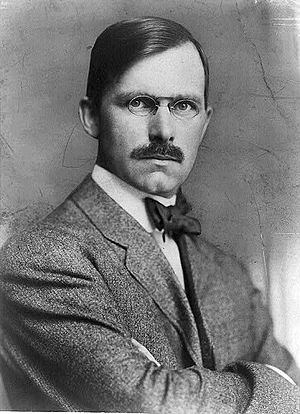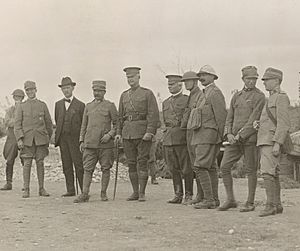Ray Stannard Baker facts for kids
Ray Stannard Baker (born April 17, 1870 – died July 12, 1946) was an American writer. He was a journalist, a historian, and a writer of biographies. He also used the pen name David Grayson for some of his books.
Contents
About Ray Stannard Baker
Ray Stannard Baker was born in Lansing, Michigan. After college at Michigan State Agricultural College, he studied law. But he soon decided to become a journalist instead.
In 1892, he started working for the Chicago News-Record. He covered important events like the Pullman Strike and Coxey's Army in 1894. These were big news stories about workers and protests.
In 1896, Ray Stannard Baker married Jessie Beal. They had four children: Alice, James, Roger, and Rachel.
Becoming a Muckraker
In 1898, Baker joined McClure's magazine. This magazine was famous for its "muckraking" articles. Muckrakers were journalists who investigated and exposed problems in society or government. Baker became well-known alongside other famous muckrakers like Lincoln Steffens and Ida Tarbell.
Baker also enjoyed writing fiction. He wrote stories for children in Youth's Companion magazine. He also wrote a series of nine books about country life using his pen name, David Grayson. The first book was called Adventures in Contentment (1910). Millions of people around the world enjoyed these stories.
Starting The American Magazine
In 1907, Baker and his friends, Lincoln Steffens and Ida Tarbell, left McClure's. They wanted to write about different topics. So, they started their own magazine called The American Magazine.
In 1908, Baker wrote a very important book called Following the Color Line: An Account of Negro Citizenship in the American Democracy. This book was about the challenges faced by Black citizens in America. It was one of the first times a major journalist wrote about this topic. The book was very successful and helped people understand the issues.
One expert, Rupert Vance, said the book was a great look at race relations in the South at that time. He said it helped future historians understand the period.
Working with President Wilson
In 1910, Baker moved to Amherst, Massachusetts. In 1912, he published The Friendly Road, which was about his travels across the United States.
That same year, Baker supported Woodrow Wilson for president. This led to a close friendship between the two men. In 1918, during World War I, President Wilson sent Baker to Europe. Baker's job was to study the war situation. He also worked as Wilson's press secretary during the peace talks at Versailles.
Baker wrote many books about President Wilson and world affairs. He wrote an eight-volume series called Woodrow Wilson: Life and Letters (1927–1939). The last two books in this series won the Pulitzer Prize for Biography or Autobiography in 1940. The Pulitzer Prize is a very important award for writers in the United States.
Later Life and Legacy
Ray Stannard Baker wrote two books about his own life: Native American (1941) and American Chronicle (1945).
He passed away in 1946 in Amherst, Massachusetts. He is buried there in Wildwood Cemetery. To honor him, several places have been named after Ray Stannard Baker or his pen name, David Grayson. For example, Grayson Hall is a dormitory at the University of Massachusetts Amherst. The David Grayson Elementary School is in Waterford, Michigan. Also, Baker Hall is an academic building at Michigan State University. There is even a trail in Amherst named after him.
Ray Stannard Baker's brother, Hugh Potter Baker, was also important. He was the president of Massachusetts State College, which later became the University of Massachusetts.
Works
- Shop Talks on the Wonders of Crafts (Chicago, 1895)
- Our New Prosperity (New York: Doubleday & Company, McClure, 1900)
- The Boys Book of Inventions (London: Harper & Brothers, 1900)
- Seen in Germany (New York: McClure, Phillips, 1901)
- Boys' Second Book of Inventions (New York: McClure, Phillips, 1903)
- Adventures in Contentment (1907) (as David Grayson)
- The Atlanta Riot (1907)
- Following the Color Line: An Account of Negro Citizenship in the American Democracy (New York: Doubleday, Page & Company, New York, 1908) read online
- New Ideals in Healing (New York: Frederick A. Stokes Company, 1909)
- Adventures in Friendship (New York: Doubleday, Page & Company, 1910) read online
- The Spiritual Unrest (New York: Frederick A. Stokes Company, 1910) read online
- The Friendly Road (Doubleday, 1912) (as David Grayson)
- Great Possessions: A New Series of Adventures (New York: Doubleday, Page & Company, 1917) (as David Grayson) read online
- What Wilson Did at Paris (New York, 1919)
- Woodrow Wilson and World Settlement (3 vols.) (New York: Doubleday, Page & Company, 1922-1923) read vol. 3 online
- An American Pioneer in Science: The Life and Service of William James Beal, with Jessie B. Baker (Amherst, Mass: Privately printed, 1925)
- The Public Papers of Woodrow Wilson. With William Edward Dodd. Six volumes. (1925-1927)
- Woodrow Wilson: Life and Letters (8 vols.) (New York: Doubleday, Page, and Doubleday, Doran) (1927-1939), "Youth, 1856-1890" (1927), "Princeton, 1890-1910" (1927), "Governor, 1910-1913 (1931)", "President, 1913-1914" (1931), " Neutrality 1914-1915" (1935), "Facing War, 1915-1917" (1937), "War Leader, April 6, 1917 - February 28, 1918" (1939), "Armistice, March 1 - November 11, 1918 (1939)" (1940 Pulitzer Prize for Biography or Autobiography).
- Woodrow Wilson: Neutrality, 1914-1915 (New York: Doubleday, Page & Company, 1935) read online
- The Countryman's Year (New York: Doubleday, Page, and Doubleday, Doran, 1936) (as David Grayson)
- The Capture, Death and Burial of J. Wilkes Booth (Poor Richard Press, 1940) read online
- Native American: The Book of My Youth (New York: Charles Scribner's Sons, 1941)
- American Chronicle: The Autobiography of Ray Stannard Baker (as David Grayson) (Charles Scribner's Son, 1945) read online
- A Journalist's Diplomatic Mission: Ray Stannard Baker's World War I Diary. John Maxwell Hamilton, ed. Baton Rouge, LA: Louisiana State University Press, 2012.
Images for kids



